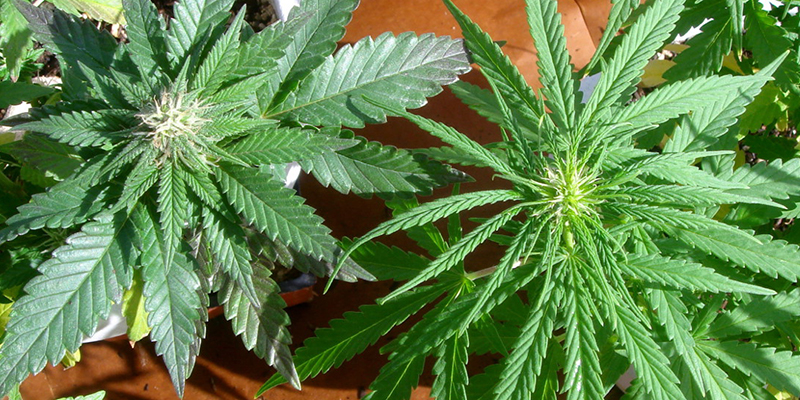Indica and Sativa are the two main types of marijuana plants. Sativa (Cannabis sativa) is often said to be energizing, while Indica (Cannabis indica) is relaxing, but the reality is not that simple.
The chemical makeup of both species can vary widely, and a plant’s effects will depend on its particular composition, not its species.

Indica and Sativa plants are also crossbred to create hybrids. Hybrid strains contain a mix of qualities from their parent plants. Every strain is unique and affects individuals differently.
This article discusses the difference between Indica and Sativa. It explains the chemical and physical differences between Cannabis sativa and Cannabis indica plants and their various effects.
Growers can immediately tell the difference between indica and sativa plants just by looking at them—their physical differences are that obvious.

Indica plants are shorter. They usually grow up to 2 to 4 feet and are compactly branched, giving them a bushy appearance. Indica leaves are also broader.
Sativa plants grow taller than indica plants, with the ability to reach between 5 and 18 feet or more. Sativa leaves are thin and the plants have fewer branches.
Hybrids, created from the cross-breeding or cross-pollination of two different cannabis plants, can vary in appearance depending on the parent plants.
Delta-9-tetrahydrocannabinol (THC) and cannabidiol (CBD) are two compounds known to produce the effects of cannabis. These compounds, called cannabinoids, affect the brain differently.
CBD and THC work by interacting with the body’s endocannabinoid system (ECS). The ECS is mainly responsible for maintaining homeostasis—the body’s ability to maintain balance in internal processes like temperature, immune responses, and mood.
THC and CBD can be found in both Sativa and Indica plants. Though the content of each can vary in every individual plant, Sativa plants traditionally have produced more THC than CBD, while Indica plants have made more CBD than THC.
However, THC and CBD amounts within a plant species are not standard, and plants of both species are now grown to produce high levels of THC.
The CBD and THC levels of hybrids can also vary depending on the plants used to create them. Hybridization is so common that the distinction between the species is often not clear-cut.
Because of this, some experts propose avoiding the terms Indica and Sativa altogether, or using them only as indicators of the plants’ height, branching, and leaf size—not their effects.

THC is commonly known to produce a “high” with effects like sleepiness, euphoria, and impaired perception and movement. Studies also suggest that THC may be able to play a role in decreasing pain.
It’s capable of causing such effects by binding to the following cannabinoid receptors found throughout the body. CB1 receptors are highly abundant in the brain.
These receptors help control many brain-related processes that influence factors like learning and memory, emotion, social behaviors, and balance. These are the main receptors that THC binds to, producing the “high” effect.

CB2 receptors are abundantly found in body tissues that play roles in immune function, such as the tonsils, spleen, and thymus.
These receptors help promote homeostasis in the body by regulating inflammatory and immune responses. THC does bind to these receptors, although not as much as it does with CB1 receptors.
How CBD produces its effects is less understood. CBD is commonly known to decrease pain and inflammation, prevent seizures, and reduce symptoms of mental health disorders such as anxiety.

But CBD does so without the “high” experienced with THC, as CBD does not bind to either of the cannabinoid receptors mentioned. Instead, it’s believed that CBD affects how THC binds with these receptors.
Research reveals that CBD seems to decrease THC’s intoxicating effects and possibly allow more positive outcomes like decreased nausea.
It’s also known that CBD interacts with other non-ECS receptors, enzymes, and cellular structures that influence factors like pain and inflammation. Some even propose that there may be a third unknown receptor that CBD binds to.

Although THC and CBD are the main compounds in Cannabis sativa and Cannabis indica, there are other cannabinoids and compounds within them that can contribute to their effects.
Examples include cannabigerol (CBG) and terpenes. Research is ongoing to determine how much of an influence such substances possibly have.
Many botanists grow hybrids to produce plants that have unique characteristics. For example, a botanist may cross-breed a ruderalis plant with a CBD-predominant indica plant so that the hybrid can have auto-flowering capabilities and a high CBD profile.
Very Well Health / ABC Flash Point Herbal Health News 2023.













































No wonder this miracle plant has been banned in order for the pharmacies to profit from the ignorance?
http://marijuana.tm/wp-content/uploads/2015/01/Sativa-and-Indica.jpg